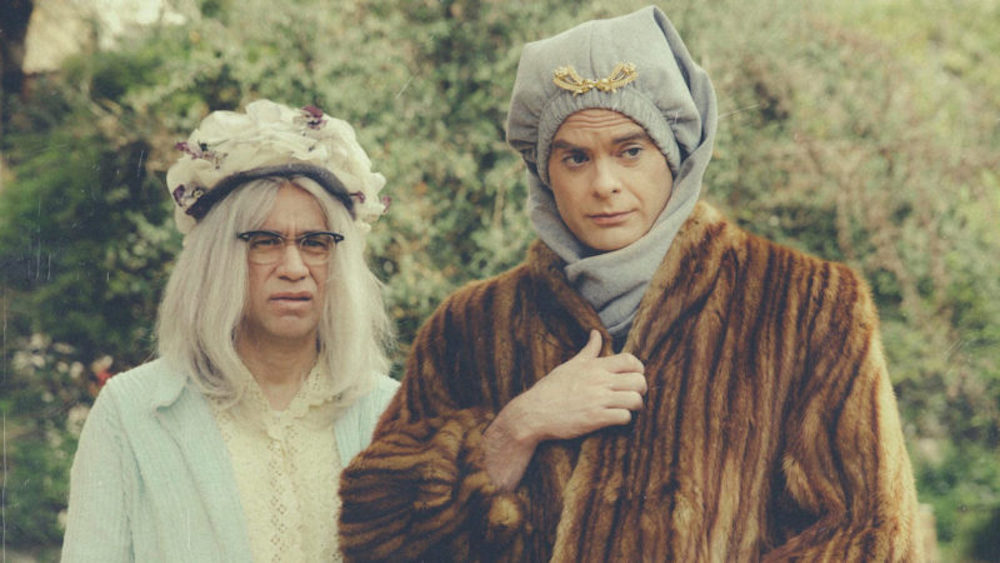In his 1962 essay ‘The Poet and the City,’ WH Auden designs the curriculum of his “dream-day College for Bards.” “The library would contain no books of literary criticism, and the only critical exercise required of students would be the writing of parodies.” Artful parody, Auden knows, is the most demanding species of critical writing. It requires, simultaneously, an understanding of the parodied work so total that it shades convincingly into empathy (the parodist has to be able to think and create within the boundaries of the parodied work) and an unfaltering critical distance. The parody documentary series Documentary Now! on the IFC channel—created by Bill Hader, Fred Armisen, Seth Meyers, and Rhys Thomas—is a sustained masterclass in just such artistic acrobatics. The series rambles back and forth through the history of documentary—from 1922’s Nanook of the North to 2012’s Jiro Dreams of Sushi—producing unpretentious 21-minute gems that crystallize and elaborate some aspect of the source classic. They are as much commentary as they are comedy, but they are in fact very funny, and often quite affecting—Bill Hader is, I believe, without qualification one of the best working American actors. These are films that the creators have deep affection for, and they put in astonishing, obsessive, painstakingly loving effort to re-create their look and texture, apparently even going so far as to track down the original lenses that Errol Morris used to shoot The Thin Blue Line. Finishing an episode, I want nothing more than to go and immediately watch the original again, to marvel at both the technical and critical achievement of Documentary Now! and the fresh light it retrospectively casts. —Matt Levin
A handsome new volume of Diogenes Laertius’s Lives of the Eminent Philosophers provides an opportunity to revisit the biographer and the popular assumptions about him. I am delighted to have acquired Pamela Mensch’s new translation of his major work, an edition you can’t read on the subway but whose large dimensions are redeemed by the readable translation, glossy color images, and a collection of new accompanying essays (The New School’s James Miller is the editor). Diogenes is the gatekeeper of ancient philosophy, yet who he really was is still a secret. The lengthy chapter on Epicurus is essential reading for those who care, as it reprints several letters by the controversial philosopher that elucidate (albeit densely) some finer points of his worldview that would be lost to us otherwise. ‘Epicurean’ is still a colloquially misapplied term for self-indulgence, and has been for over two thousand years, diminishing one of the most interesting philosophical schools in world history—the seriousness of Laertius’ treatment of Epicurus suggests he himself may have been one of his followers. Of the scholarly essays, I most enjoyed Glenn W. Most’s “Diogenes Laertius and Nietzsche” for its reassessment of Nietzsche’s study of Diogenes, a largely forgotten element of his oeuvre. Biographies can certainly get far more scandalous than Lives, but the personal lives of our intellectual ancestors are always juicy, forbidden fruits. —Ben Shields
We’ve all had bad days. Days with cold showers, stubbed toes, and telemarketers. Days with slow drivers and missed trains and hangovers. Marquis de Sade’s Justine (also known as The Misfortunes of Virtue) is a satirical ode to all the things you just can’t control. The story of the unfortunate twelve-year-old, Justine, is in short, appalling. She begins her tale as an penniless orphan wrongfully accused of theft and forced to join a gang, and it only gets worse from there. (If you’d like an idea of some of the “misfortunes” that transpire, take a look at ‘Sadism Illustrated’). Due to Sade’s reputation as an erotic writer, many have dismissed Justine’s tale as purely pornographic. However, within the horrific sexual scenarios and impossibly unfortunate events is an expertly organized philosophical critique of French society during the Revolution and of humanity in general. Is it in our nature to be vicious or virtuous? The trials of Justine provide arguments for both. The novella is peopled by thieves and abductors who engage in remarkably rational and witty rapport with their victim, not unlike when a Disney villain reveals their entire scheme right before enacting it. Usually, though, the hero manages to escape, while in this case, Justine does not. So the next time you get a hangnail or miss your train, I’d recommend Justine, a hefty dose of moral despair à la Marquis de Sade. —Madeline Day
The children fleeing the Northern Triangle—Honduras, El Salvador, and Guatemala—only to end up in legal purgatory and detention hell here in the States are refugees. Valeria Luiselli establishes this early in her book-length essay, Tell Me How It Ends, and though the assertion seems obvious, the misery burns on. The book is a searing indictment of the mishandling of the Central American child migrant crisis. Luiselli insists that the ways we frame narratives and the devices we use to tell stories have a meaningful impact on the world. “In the media and much of the official political discourse, the word ‘illegal’ prevails over ‘undocumented’ and the term ‘immigrant’ over ‘refugee,’” she writes. “How would anyone who is stigmatized as an ‘illegal immigrant’ feel ‘safe’ and ‘happy’?” Language matters. In the hands of the oppressor, it divides, dehumanizes, and constricts. Just imagine what could happen if we paid attention and used words and stories for good. —Brian Ransom
Not next week but the week after, Wave Books will publish a reissue of Danielle Dutton’s 2010 novel SPRAWL with an afterword by Renee Gladman. I’ve read Dutton’s short fiction (most recently her excellent story “Somehow” in our Spring issue), but I picked up the new edition of SPRAWL just this Tuesday. It’s a cousin of Woolf’s stream of consciousness, focused almost entirely outward, and constructs, in the mundane setting of an unnamed suburb, a world of unexpected intensity. Formally, SPRAWL treads deftly and deliberately, operating, for the most part, in the present tense. The vibrancy of the narrator’s exterior world is punctuated by brief moments of interiority expressed with succinct lucidity. The eerie, atmospheric prose eschews even paragraph breaks, reading as one long scroll; the spare formal structure clears space for Dutton’s language to stretch. The novel, in Gladman’s words, is “the most tactile of all other possible architectures … I was moving through a world where every nominal thing, every act, every observation, every shift in time, every body passing the window and every body occupying a room in the house of this neighborhood was also an aggregation of marks on a surface…they flattened without hierarchy.” One of the novel’s many successes is that its narrator never succumbs to the malaise baked into the trope of the suburban housewife. Although she is often affectless, she is always keenly aware of her project: “Most of the time I’m pretty much anywhere … In some sense I’m madly in love, or I’m transformed into a kind of habitat, or I match the wallpaper with my eyes. It’s confusing to have so many plausible alternatives. So I measure our range, our suppleness.” This novel is a captivating exercise of language as a medium, a still life in just over a hundred pages. It ends with an enigmatic last line, an almost apologetic sigh from the narrator telling us she ultimately cannot hold everything at once: “It takes a long time, maybe eighty-five years, and it is the opposite of a snapshot.” —Lauren Kane
from The Paris Review https://ift.tt/2PCq4jY



Comments
Post a Comment